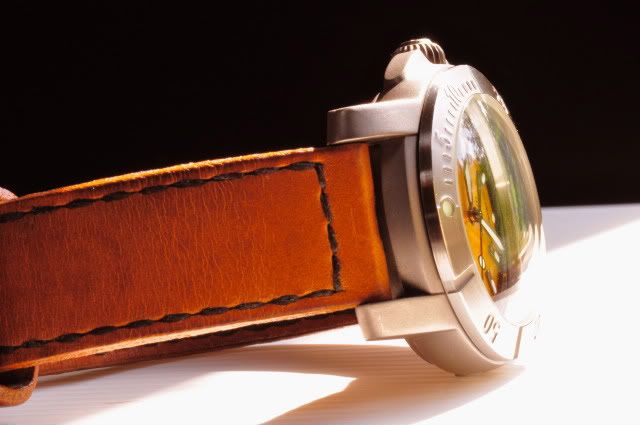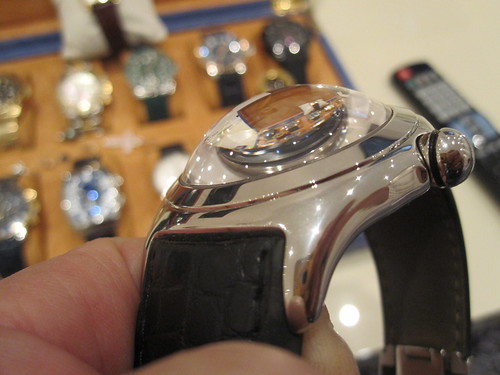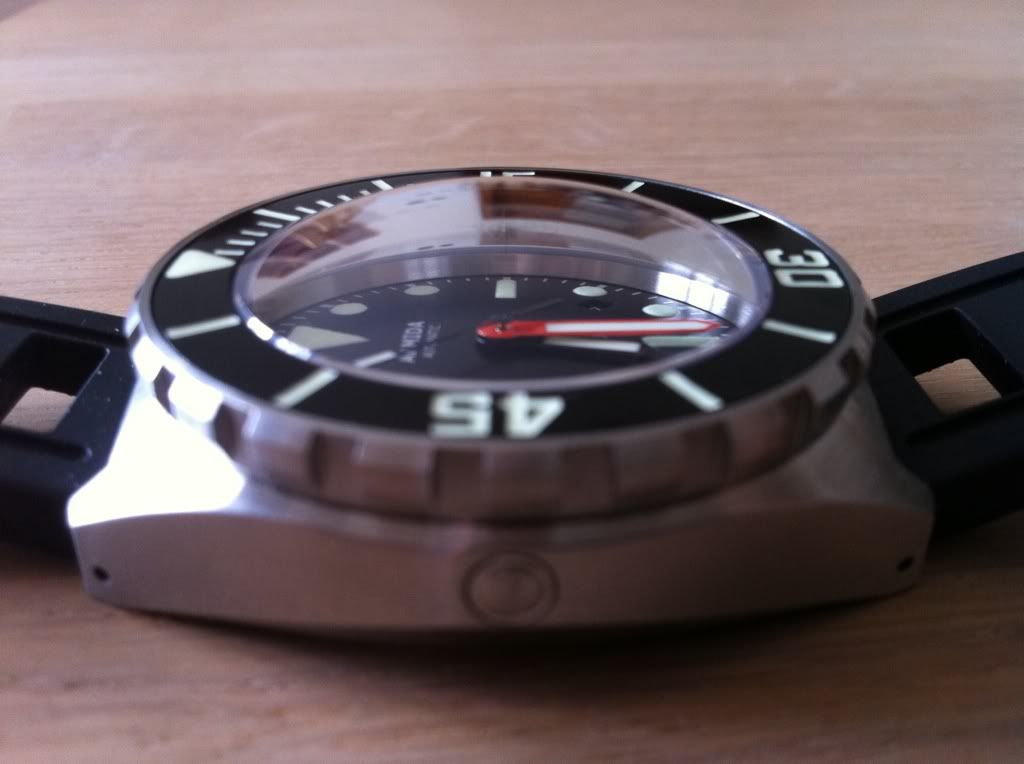Panerai offer a number of models with domed crystals, sapphire and plexi
Would be grateful for any views as to why domed sapphire crystals are not used more extensively - I for one would love to see a submariner with one, think it would be a huge improvement. I think it would make many watches so more appealing.
Are they really so difficult/costly to produce?
Chris
Panerai offer a number of models with domed crystals, sapphire and plexi
B&M Capeland S XXL - best domed crystal I have ever owned.

“Don’t look back, you’re not heading that way.”

No.
Fuhermore the cost of sapphire is peanuts against the uplift the watch can be sold at with this spec.
The problem with sapphire is that it has a higher rate of light refraction than glas than acrylic.
AR only partly compensate for this.
Domed this problem is more noticable as at about any angle the dial is partly hidden behind reflection.
I'm a strong supporter of domed sapphire. Flat ones are so... flat :)

my steinhart vintage military has a partially domed sapphire so it can't be that expensive to produce
ktmog6uk
marchingontogether!
Quite.
Sapphire isn´t that costly.
It is simple a ´need´ and results in extra margin for a basically unnecessary ´higher´ spec.
My Vostok 1967 has a wónderfull highish dome in mineral cristal, the halfway station. I would have preferred acrylic but at least it is not sapphire and costing more for less.


i too like domed crystals or even top hats... but i guess, since they protrude above the bezel it would be one of the 1st things to get hit on the watch... perhaps that's why most manufacturers go flat nowadays... just a guess...


I prefer flat sapphire, it only reflects at one angle and does not distort the view of the dial/hands.
Sapphire can be quite expensive if you want to make a custom shape. Especially if you want to make a thin and high-dome glass. Cheaper brands probably use standard size crystals from Sternkreuz or similar.
Theres also varying qualities, I've seen some china-made crystals with inclusions that look almost like scratches from certain angles.

I really like domed sapphire crystals. But I also have had some with an outer A/R layer, that were horrible scratch magnets. If you don't like scratches, bear that in mind. On the other had, I once had the scratched A/R layer removed from a crystal, a job that was unexpectedly easy to do.
This one ia a bit domed


The disadvantages are not really related to the RI (refractive index) The difference of RI between good quality Pure crownglass (about 1.50) and impure Crown glass (1.75) are not the issues which would affect this application.
White sapphire has an RI of around 1.77 . But would be useless in this application, as you would never find a crystal un-included enough.
The usefulness of materials for watch crystals are more related to other factors affecting the optical properties. Low refractive index would help somewhat, more important is low dispersion, Abbe numbers closer to 50 than 80.
When Sapphire crystals are made it is the dispersion, Abbe numbers, which are lifted. It is this that reduces slightly their optical quality, in favour of hardness
Last edited by java; 16th September 2012 at 00:38.

Please get your facts sorted and even thén insulting is simply a display of poor form.
A fundamental property of any optical material is its index of refraction. This number is the ratio of the velocity of light in a vacuum divided by the velocity of light in the optical medium. Since the velocity of light in any material medium is always is less than it's vacuum velocity, this number is always positive and larger than one (There is current research in building specially fabricated optical structures, meta-materials, that create a negative index). The index of refraction of a material is also dependent on the wavelength of the light. A material could have a different value with red light versus blue light. A materials dispersion is just this difference between the index at the long wavelength red versus the short wavelength blue. For people designing lenses, dispersion is the cause of chromic aberration, the focusing of different color at different places. Optical materials that have low dispersion have a relative flat curve of their index versus the wavelength of light, such as acrylic. Hight dispersion materials are materials such as lead glass or diamond.
This high refraction is what makes the diamond sparkle but it is also what makes a sapphire cristal surface reflect significantly more than glaas and more still than acrylic.
The index of refraction for relevant optical materials:
Acrylic 1.49
Optical Glass (depending on composition) 1.5 - 1.7
Sapphire 1.77
My facts are 100% right, as your almost exact reitteration in your googled version confirms. Firstly because unlike you I didn't just google them to impress. There is little more annoying on fora, than people who do just that.
I am reasonably conversant with the subject. Not least because my wife has a Fellowship with the Gemological Association of Great Britain and is also a Graduate Diamond grader with the GIA (Gemological Institute of America)
So I get my information first hand from a specialist in the way in which minerals handle light.
It is clear from your googling diatribe that it is not a subject you have a great understanding of. So why pretend to speak with great authority on it.
Last edited by java; 16th September 2012 at 18:48.
Did someone say domed? Not as impressive as Javas but I love it

Last edited by Huertecilla; 17th September 2012 at 15:37.
which is getting out of hand a bit.
I'm no expert by any means, but the so called "double domed" crystal on my Kingston, which is sapphire is very readable from any angle.
I can't be arsed about brittleness or weight.
Daddel.
Got a new watch, divers watch it is, had to drown the bastard to get it!
Ah, that is the ´good enough´ applied to sapphire now??
Why doesn´t it apply to lower scratch resistance of anotherwise for watch purposes superior material that costs peanuts to replace?
Do we wánt the watches and parts to be more expensive for lesser functional specs?
Got a new watch, divers watch it is, had to drown the bastard to get it!

[QUOTE=
Are they really so difficult/costly to produce?
Chris[/QUOTE]
I doubt they cost more to make really. Look at Oris and Hamilton for the cheaper end brands. Often have domes rather than flat. For me, a dome often 'makes' the watch, rather than a flat reflective pane like Rolex use
Cheers all
Tim

I hate to say it, but the RI is exactly the problem with sapphire compared with e.g. plexiglass/PMMA. The surface reflectance increases with refractive index. This is desirable in diamonds as it makes them sparkle, but undesirable with watch crystals and camera lenses as it makes surface reflections more visible, whether it be on flat or domed surfaces. Hence the need for AR coatings on high-index materials used in camera lenses/spectacle lenses/watch crystals.
Dispersion/Abbe values are only relevant with refractive surfaces i.e. those with lens power, as they represent how much the light of different wavelengths are refracted releative to each other.
Lots of technical stuff here that I don't fully understand, and thankyou for the explanations. Seems this has almost developed into sapphire v acrylic argument, rather than flat v domed. As far as acrylic goes, yes it looks nice, but I really do not want a watch that collects scratches so easily on the crystal, even if they can be polished off. As for trade off between optics of a domed crystal v a flat one, I personally would accept a small loss of clarity for the aesthetics of a nicely domed crystal. IMHO of course.
Chris
Last edited by Crispin; 21st September 2012 at 13:55.
Refraction happens only ever at the surface, when light travels from one substance to another. Further refraction can only take place if there is a change in the nature of the substance. The refractive problems are much more complex with multi-elemental optical systems such as camera lenses, where light goes air glass air several times. Multiple and complex coatings required for this are very different from the simple AR coatings used on watch crystals.
That said. I also don't have and don't want any watches with acrylic crystals, although I freely accept that they are better for seeing the dial.
Back to domed. I think some magnificent designs are possible with the use of domed sapphire crystal. Corum even used faceted sapphire crystal.
Last edited by java; 17th September 2012 at 19:16.
It depends what you want. Domed on the top and flat underneath is relatively cheap but can produce weird refractive effects. Double domed (polished domed on both sides) is very expensive; Sinn, for example, charges more than 300 euros for a double dome sapphire on their 356.
Eddie
Whole chunks of my life come under the heading "it seemed like a good idea at the time".

Sapphire or any alternative will be homogenous enough that there is very little further refraction within the crystal. Clarity is more down to impurities - which will be very good.
The AR coatings on camera lenses are actually very similar to the mutli-layered coatings on the good quality AR used on modern watch crystal e.g. Breitling have very low overall reflectance/very high overall transmission.
Cost is relative....
A sapphire watch crystal is about 5 times more expensive than mineral crystal and about 4 times more expensive than plastic crystals.
And, a domed sapphire produces more waste than a flat sapphire, the higher the dome, the more waste, so higher the cost.
Also, the cost of sapphire grows disproportionally as the diameter or thickness increases. This is because sapphire is grown as a long tube shape (a "boule"), then sliced into waffers. For a domed crystal, the waffers have to be thicker (fewer per boule), and the larger the crystal diameter, the larger the boule.
(Granted, it costs about a just a few bucks to make an average sized flat sapphire watch crystal...)
Here's my domed Armida A1.
It was the dome that attracted me to this in the first place.
Malc



I like domed crystals, whether sapphire or acrylic. But on sapphire the manufacturer has to incorporate effective AR coatings, and some don't bother or do it very well. It's the main reason I sold my Hamilton.
Yet this perceived ´higher´ spec nets a lót more than an acrylic window. Thát is why it is sold to us as being better.
A double domed sapphire is plain silly; oops .. luxury, when compaired objectively to an acrylic alternative. It is extremely costly; both in functionality and money, to buy and only buys scratch resistance.

so how about the solution used for a while by Seiko, the Sapphlex?
ktmog6uk
marchingontogether!